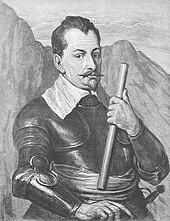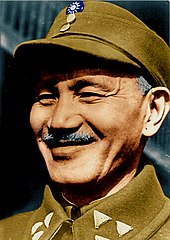Generalissimo

Generalissimus (from Italian Generalissimo , about " General of the Generals") is an outdated term for a position in chief. The generalissimo was empowered to act both militarily and politically on his own responsibility. The term is used to designate a commander-in-chief of all armed forces of a country who is above the marshals and generals .
Albrecht von Wallenstein was the imperial instruction from June 27, 1625 "for a general about this our men after the Holy Roman Empire seconded succor ." He was the only Habsburg general to receive this rank and title as absolute commander-in-chief of the imperial armada, as general of the generals , who was placed above the commanders (including Lieutenant General Tilly) of the league armies. In parlance, this leads to the title of generalissimo.
In the Habsburg Monarchy , the generalissimo had the authority of the lieutenant general (highest rank of general in the 17th century); unlike the latter, however, the generalissimo was not subject to the Vienna Court War Council and was allowed to act autonomously. If a generalissimo was appointed, the position of lieutenant general remained vacant during his term of office.
In more modern times, the term generalissimo was used again as the military title of various dictators - often accompanied by a personality cult .
Examples
- 1625 or 1632: Albrecht von Wallenstein ( HRR )
- 1634: Matthias Gallas (HRR) *
- 1641: Lennart Torstensson ( Sweden )
- 1673: Ruprecht von der Pfalz, Duke of Cumberland ( England ) *
- 1702: Franz du Hamel ( Republic of Venice )
- 1702: George of Denmark (Great Britain)
- 1716: Friedrich (Sweden)
- 1727: Alexander Danilowitsch Menshikov ( Russia )
- 1740: Anton Ulrich von Braunschweig-Wolfenbüttel (Russia)
- 1792: Nikolaus von Luckner ( France )
- 1799: Alexander Wassiljewitsch Suvorov (Russia)
- 1806: Karl von Österreich-Teschen (Austria)
- 1812: Francisco de Miranda (Venezuela)
- 1821: José de San Martín (Peru, Argentina, Chile)
- 1823: Michael of Braganza ( Portugal )
- 1846: Antonio López de Santa Anna ( Mexico )
- 1918: Ferdinand Foch ( France - Commander in Chief of the Allied Forces)
- 1927: Zhang Zuolin ( China - Beijing) (Grand Marshal)
- 1928: Chiang Kai-shek (China - Nanking , later Taiwan)
- 1933: Rafael Trujillo ( Dominican Republic )
- 1936: Francisco Franco ( Spain ) ( Generalísimo - October 1, 1936)
- 1945: Josef Stalin ( Soviet Union - June 27, 1945; Russian Генерали́ссимус Сове́тского Сою́за )
- 1992: Kim Il-sung ( North Korea ) ( Dae Wonsu , "Grand Marshal")
- 1992: Than Shwe ( Myanmar )
- 2012: Kim Jong-il ( North Korea ; posthumous)
*) It is unclear whether Matthias Gallas and Ruprecht von der Pfalz actually carried this title.
The title General of the Armies of the United States is comparable. He received:
- 1776: George Washington , who was posthumously appointed in 1976 to, as well as commander of the Continental Army public Generalissimo was called
- 1919: John J. Pershing as Commander in Chief of the American Expeditionary Forces in Europe
In addition, some commanders-in-chief were designated as Generalissimo without having received that rank:
- 1702: John Churchill, 1st Duke of Marlborough as Commander-in-Chief of the States General (Netherlands)
- 1939: Maurice Gamelin , Général d'Armée, Généralissime as commander of the French armed forces
- 1940: Maxime Weygand , Général d'Armée, Généralissime , successor to Gamelin
See also
literature
- Sources and research on patriotic history, literature and art , ed. by Wilhelm Braumüller, Vienna 1849.
Remarks
- ↑ Hellmut Diwald: Wallenstein , Goldmann Sachbuch, Munich / Esslingen 1981, p. 286 f.


